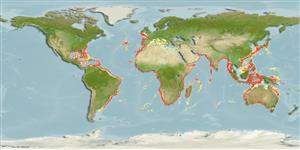Classification / Names
Common names from other countries
Main reference
Size / Weight / Age
Max length : 170 cm TL male/unsexed; (Ref. 94782); 145.5 cm TL (female)
Length at first maturity
Lm ?, range 105 - 118 cm
Environment
Marine; bathydemersal; depth range 50 - 1440 m (Ref. 247), usually 200 - 600 m (Ref. 247)
Climate / Range
Deep-water, preferred 24°C (Ref. 107945); 51°N - 43°S, 98°W - 156°E
Distribution
Eastern Atlantic: France to South Africa, including the Mediterranean (Ref. 31367). Western Central Atlantic: northern Gulf of Mexico (Ref. 247, 6871). Indian Ocean: Mozambique, South Africa and the Aldabra Islands (Ref. 31367); Western Australia (Ref. 6871). Western Pacific: Japan, Papua New Guinea, and Australia (Ref. 31367). Not in the Eastern Pacific (Ref. 94782).
Countries | FAO areas | Ecosystems | Occurrences | Introductions
Short description
IUCN Red List Status (Ref. 115185)
Threat to humans
Harmless
Human uses
Fisheries: minor commercial
More information
ReferencesAquacultureAquaculture profileStrainsGeneticsAllele frequenciesHeritabilityDiseasesProcessingMass conversion
Tools
Special reports
Download XML
Internet sources
Estimates of some properties based on models
Phylogenetic diversity index
PD50 = 0.5003 many relatives (e.g. carps) 0.5 - 2.0 few relatives (e.g. lungfishes)
Trophic Level
4.1 ±0.4 se; Based on diet studies.
Resilience
Low, minimum population doubling time 4.5 - 14 years (Fec assumed to be <100)
Vulnerability
Very high vulnerability (87 of 100)
Price category
